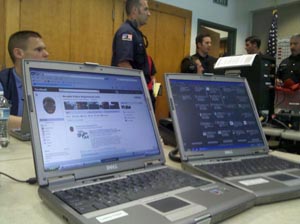 The Emergency Operations Center (EOC) for the City of Arcadia was activated during a mock earthquake drill on Thursday, October 20, 2011. The drill was conducted in conjunction with the Great California ShakeOut, a statewide earthquake and preparedness drill. Participation in this type of drill is not new for the Arcadia Police Department; however, this was the first time that social media monitoring was introduced to the event.
The Emergency Operations Center (EOC) for the City of Arcadia was activated during a mock earthquake drill on Thursday, October 20, 2011. The drill was conducted in conjunction with the Great California ShakeOut, a statewide earthquake and preparedness drill. Participation in this type of drill is not new for the Arcadia Police Department; however, this was the first time that social media monitoring was introduced to the event.
In the event of a true emergency or disaster, it is likely there will be interruptions in traditional communications platforms, such as landline phones and even cellular service. As evidenced by actions after the Haiti and Christchurch earthquakes, community members may very well turn to alternative means of attempting to communicate with public safety and other emergency response organizations. Social media platforms, like Twitter, were widely used by those seeking aid when conventional phone lines did not work. By introducing social media platforms to our EOC operations, the Arcadia Police Department can offer our community alternative access to public safety services during a disaster or large scale emergency. This social media monitoring is in no way meant to replace 9-1-1 or standard methods of reporting to public safety, but rather, to enhance our capabilities to better serve our community.
Current staffing levels and equipment do not allow day-to-day monitoring of social media platforms by our department. This new implementation of potential monitoring will only be used during full-scale activations of our EOC. The primary mission of social media use by the Arcadia Police Department remains community engagement and information sharing, not as an immediate response means of communication. Always dial 9-1-1 to report emergencies or in-progress calls for service.
During this drill, personnel monitored two primary social media platforms: Facebook and Twitter. The Arcadia Police Department accounts on each platform were monitored, along with keyword searches for terms associated with the City of Arcadia and our agency. Other keywords dealing with community specific sites, such as Methodist Hospital, the IS 210 Freeway, and Santa Anita, were monitored and queried. Additional methods and tools were utilized for monitoring Internet traffic to include, “geo-tagged” photos and messages within our community.
The intent of this proactive social media monitoring drill was to better prepare our personnel for our response to disasters or emergencies. Although the social media engagement on behalf of our agency started a little over two years ago, this is the first application within emergency management. Through our presence online, we have been able to build a base of users within and around our community before the need arises. Some of the many benefits to social media participation within emergency management may include: the ability to proactively listen and potentially see problems before they are reported to staff, potential for additional “eyes” on a problem, the ability to assess and verify incoming information, influence rumor control, provide information such as shelters or evacuation points, and to act as an alternative reporting and communications venue.
And, it is not just social media that we have added to our tool kit in the EOC. The Arcadia Police Department also uses the instant messaging service, Nixle, to deliver messages direct to our community and beyond. Nixle allows the department to send emergency, advisory or community alert messages to the subscriber via text (SMS) and/or email. Unlike social media, this form of instant messaging is only for outbound communication, but nonetheless, a valuable tool. Nixle will be used in addition to our social media, as well as the “Alert LA County” call-back program, which targets primarily landline phones within a geographic area.
Introduction of these services to our Emergency Operations Center will only enhance and improve our service delivery in a disaster or large scale emergency. It is imperative to remember though, that public safety resources will be taxed when disaster strikes. Daily services and response times will be “out the window,” and our community must be prepared to assist themselves and one another, quite possibly without public safety assistance. Please take the time to visit online resources, such as the American Red Cross and ShakeOut, and make use of the resource information they provide.

